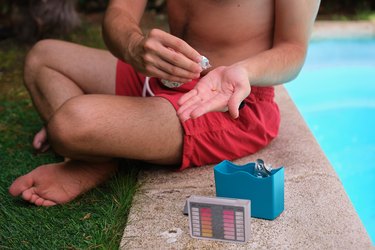
The key to keeping your pool water clear and free of algae and other contaminants is to maintain the balance of sanitizing chemicals, and that begins with adjusting the acidity. Acidity (and its opposite, alkalinity) is measured by pH, which ranges from 1 to 14. A pH of 7.0 is neutral (neither acidic nor alkaline), and the recommended pH for pool water is a slightly alkaline value from 7.2 to 7.6. A pH in this range strikes a balance between optimum chlorine availability and safe swimming.
Acidic water is actually a good thing as far as chlorine levels are concerned because both calcium hypochlorite and sodium hypochlorite — the two most common pool sanitizers — are also acidic when introduced into pool water. However, acidic water with a pH below 7.0 is corrosive and can damage metal pool equipment, and it can hurt your skin and eyes. So, if the pool water tests acidic, you should raise the pH before adding chlorine.
Video of the Day
Video of the Day
How to Raise pH With Baking Soda
Baking soda is pure sodium bicarbonate, and there isn't any difference between the product you use in the kitchen and that available at the pool supply center. It's a natural alkalinity increaser for pools, and when you add it to pool water, it raises both the pH and total alkalinity, which is a measure of the ability of the water to resist changes in pH. The total alkalinity of the water should be between 110 and 150 parts per million (ppm) to prevent it from turning acidic.
There's no specialized procedure for adding baking soda to pool water. After testing pH and alkalinity, you just pour in the amount you need to raise the alkalinity to the proper level based on the volume of the pool. It takes 1.5 pounds to raise the alkalinity of 10,000 gallons of water by 10 ppm. If the pH is below 7.2, add twice this amount to simultaneously raise the pH. Scatter the powder over the surface of the pool, give it about six hours to dissolve and then run the pool pump to circulate it. Repeat if necessary.
How to Sanitize With Chlorine Bleach
Once you've balanced pH and alkalinity, it's time to measure chlorine levels and add more if necessary. For optimum sanitization, the chlorine level should be between 1 and 3 ppm, and if it's too low, one way to bring it up is to add a liquid chlorine bleach, like Clorox. It isn't the most effective way to add chlorine, but it works.
The amount of bleach you add depends on the concentration of sodium hypochlorite in the product you use. Like most products, Clorox is a 5 percent solution, and the company recommends adding between 100 and 200 ounces per 10,000 gallons of pool water. That's a little less than two 121-ounce bottles. Pour in the bleach, give it time to circulate, test the chlorine level, and add more bleach if necessary.
Maintaining Chlorine Levels
It's important not to add too much baking soda because if the pH exceeds 7.6, the chlorine you add to the pool water will be neutralized. You bring down pH by adding dry acid (sodium bisulfate) or muriatic acid pool additive. The amount you add depends on the pool volume and the pH value you measure.
Even if the pH is balanced, chlorine levels can drop quickly because chlorine reacts with sunlight and becomes unavailable for sanitizing. Avoid this by adding a chlorine stabilizer; the most common one is cyanuric acid. Pool sanitizing tablets already contain this, but if you're sanitizing with bleach, you have to add it separately. A concentration of 300 ppm is ideal.